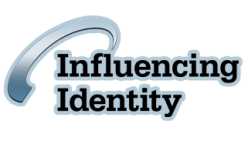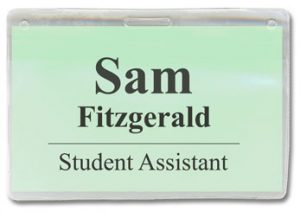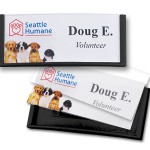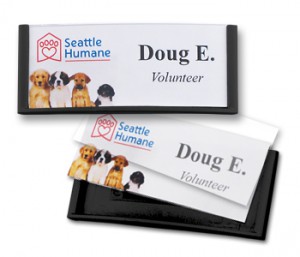While “John Doe” or “Jane Smith” are a bit more professional, it may not always be appropriate and safe using last names on name tags. Not everyone enjoys wearing a name tag while at work, but most organizations and companies find them necessary for communication and branding. Most restaurants require serving staff to wear personal identification. Name tags and badges are also often seen in retail settings. They are even worn in office buildings.
And, not just cashiers and waitresses wear these identifiers. Managers, security and CEOs also wear name tags on a regular, if not a daily, basis. Name tags are a great way to quickly identify someone if you need help with something. And, as such, they are often a required part of a work uniform.
Having a person’s full name on a name tag can be quite helpful to a consumer, however it may also be dangerous to the employee who is wearing the name tag. These name tags have been recently scrutinized for their validity. Safety issues have also come up in many conversations.
Question: Why would having both your first and last name on a name tag be dangerous to an employee?
There have recently been several studies and panels evaluating the usage of first and last names on name tags. They have concluded that a person’s safety and privacy might be endangered outside of the workplace should a consumer attempt to locate or make contact with an employee. However, this misuse of someone’s name has been proven highly unlikely by the same studies as above.
Question: Why would someone need to have both their first and last name on a name tag? Does it depend on the type of work you are doing (i.e. customer service vs lawyer)?
Again, “John Doe” or “Jane Smith” are a bit more professional than “John” or “Jane.” However, some companies and business types require that employees use last names on name tags. Typically wait staff at a restaurant is only identified with a first name. The same goes for someone in a retail situation.
In an office setting last names would be appropriate to use as a more professional way of identifying someone in their current position. By using someone’s last name on their name tag, it provides the prestige that can accompany a specific title in a company. It also helps current and future clientele identify the person with which they need help from.
Question: What happens in situations where security may be a factor, such as detention facilities, schools or hospitals?
Typically in security situations, name tags are used to determine if someone should be where they are. In places like schools these name tags are often used as a means to enter the building. They are also used to help students know who teachers and school workers are. This, in turn, helps them feel more secure.
The argument can be made that first names are not necessary when referring to Mrs. Smith as a teacher. However, the same argument can be made in hospitals that “Jane Smith” might be providing too much personal information to a patient. “Jane” would suffice in this instance.
Whether or not to use someone’s last name on a name tag is not necessarily an easy answer. However, in many circumstances, certain levels of personal identification are needed. They provide a service to consumers, and they also provide security in many situations. Make sure your reasons for using last names on name tags fit not only your needs, but your security situation.











